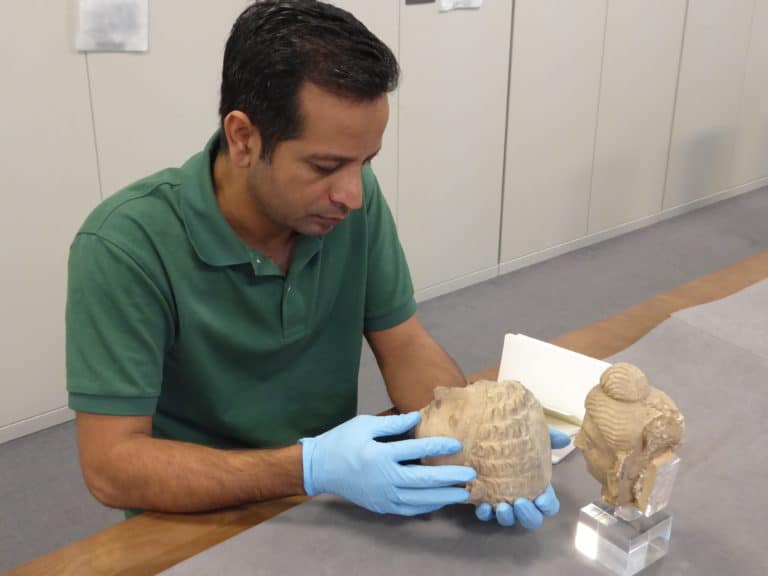Last year I was invited to undertake an artist residency by Gandhara Connections, a project by the Classical Art Research Centre at the University of Oxford. The project is set to build upon the network and research on Gandharan Art and its links to the classical world of Greece and Rome, thousands of kilometres to the west. My residency with Gandhara Connections started in August 2019, with the initial challenge to respond to the Ashmolean Museum’s Gandharan art collection within one year, and then to present my work at a solo exhibition at the Museum in Summer 2021.
I have always been interested in Gandharan sculptures. I find them beautiful and seductive. I remember even my earlier portraits from 2005-6 were inspired by Buddha’s head sculptures which I’ve seen many times at the Lahore museum.

I formalized my proposal for Gandhara Connections when I was shortlisted for the 2018 BMW prize at Art Basel, Hong Kong. I did not get the prize though. Later my gallerist Amrita Jhaveri had a chance to share the proposal with Dr Peter Stewart, Director of the Classical Art Research Centre at the University of Oxford, and with Professor Mallica Kumera Landrus, keeper of Eastern Art and Curator of Indian, Himalayan and Southeast Asian Art at the Ashmolean Museum, Oxford. They both got interested in the idea, and with the help of the Bagri Foundation, they brought me to Oxford to start this exciting journey between traditional and contemporary art.
During my Oxford residency, I had a chance to see all the Gandharan artefacts in the collection. Taking advantage of my privileged position as artist in residence, I nearly opened all of the boxes in storage, held the pieces in my hands, and made sketches as a personal response to the artefacts. I also had the occasion to immerse myself in the wonderful Company School drawings, Mughal miniatures and Mesopotamian artefacts.
Gandharan art is such an established and aesthetically developed art form. For me the challenge is to maintain its essence, take inspiration, avoid imitation, and make something new and relevant to our time and current discourses in contemporary art.
Over the years, I have made an extensive body of work based on the ideas of ruins, time, and memory. I took inspiration from the remaining mounds of the Indus Valley Civilisation, which are not yet excavated. The mounds are full of tons of red terracotta pottery shards which totally transform the colour of the surface of the landscape, making it look like a kind of Martian or otherworldly scenery. I got interested in constructing a fictional narrative by creating large landscape/ruin-scape watercolour drawings, ceramics, drawings of the clouds and storms on Mylar paper. This very interest led me to explore Gandharan art further.


Art forms such as Gandharan that served devotional purposes for such a long period of time have, in my opinion, some inherited spiritual qualities to them. One cannot deny their sacred attributes. The maker infused such devotion into these art objects that they have a deep impact on the viewer over the centuries.
As a contemporary artist, my aim is to take inspiration from the same core of Gandharan art, which is to me, spirituality. The new work I am developing from my residency at the Ashmolean Museum is based on faith and how art creation is inspired by religious and traditional aspects of personal beliefs. For next year’s solo exhibition, I am working on a series of watercolour paintings and drawings, and possibly some ceramic pieces to respond with a contemporary eye to the rich Ashmolean collection of Gandharan artefacts.
The fourth international Gandhara Connections Workshop supported by the Bagri Foundation, ‘The Rediscovery and Reception of Gandharan Art’, will take place at the Ioannou Centre at the University of Oxford on Thursday 26th and Friday 27th March 2020.
About Ali Kazim
Born in Pakistan, Kazim received his BFA from the National College of Arts in Lahore (2002) and an MFA from the Slade School of Fine Art in London (2011). In 2018 Kazim was one of three shortlisted for the prestigious BMW Art Journey. His particular interest is the relationship between history and culture, and the invisible workings of nature and time implied by the physical traces of ancient art and artefacts.
About Classical Art Research Centre
The Classical Art Research Centre, Oxford University, leads and supports research on ancient art. At its heart is the Beazley Archive, which includes the world’s largest collection of images of ancient figure-decorated pottery


